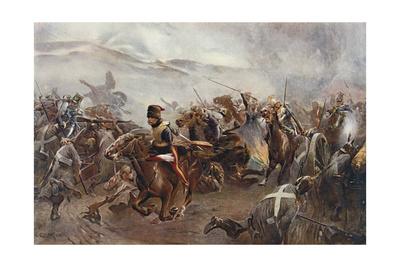

Unfortunately, Nolan was also highly critical of the cavalry's performance in general thus far, and of Lucan's personal leadership in particular. Immediate' The order was given to Captain Edward Nolan to deliver to Lucan as time was of the essence and Nolan was an excellent horseman who had served in the Austrian Army and had written a couple of books on cavalry tactics. 'Lord Raglan wishes the cavalry to advance rapidly to the front, follow the enemy and try to prevent the enemy carrying away the guns. After waiting a little longer (partly to see if the remainder of the infantry appeared) he dictated another order to General Airey, the one that would become the centre of much controversy. As captured guns were often used to claim victory, Raglan was anxious to stop the Russians from hauling the guns away. Unfortunately, Lucan did not have the vantage point Raglan had, who could see the Russians preparing to haul away a number of the guns they had captured at the redoubts. At this point, Lucan decided to wait for infantry support before moving against what would be prepared enemy positions. He immediately moved the Light Brigade into the North Valley and kept the Heavy Brigade in the South Valley near No. There should have been little doubt in Lucan's mind as to the meaning of the order, although at that moment only one infantry division would have been visible. They will be supported by the infantry which have been ordered to advance on two fronts.' There was only one Heights to recover, that of the Woronzov Heights, and that he was to be supported by infantry meant the 1st and 4th Divisions were on their way to make a co-ordinated assault on the Heights. At about 10.15 he dispatched an order to Lord Lucan: 'Cavalry to advance and take advantage of any opportunity to recover the Heights. Unfortunately, the opportunity had been missed by the time Lord Raglan decided to use the cavalry to dislodge the Russians. The best time to have made such an attack was shortly after the Russian cavalry force had routed over the Heights. Lord Raglan had hoped that they could be used to recapture the Woronzov Heights, starting with No. There was a long delay however in following up the success of Scarlett and the Heavy brigade as the two infantry divisions under the Duke of Cambridge and Sir George Cathcart took a very long time to start moving and reach the field of battle.
:max_bytes(150000):strip_icc()/William_Simpson_-_Charge_of_the_light_cavalry_brigade_25th_Oct._1854_under_Major_General_the_Earl_of_Cardigan-5c057e42c9e77c000109ee84.jpg)
Having been badly shaken up by the charge of the Heavy Brigade under Brigadier-General James Scarlett, Lieutenant-General I I Ryzhov and his cavalry reformed at the eastern end of the North Valley protected by Zhaboritski's infantry and artillery on the Fedioukine Hills and other Russian forces on the Woronzov Heights.

An opportunity at this point had been lost as Lucan had had a chance to attack the Russian cavalry's flank as it engaged the Heavy Brigade but had refused to move as Raglan had ordered him to defend his position. After the Russians had seized the outer perimeter of defences (Redoubts 1 to 4 out of six) on the Woronzov (Causeway) Heights in the early morning, they had attempted to force their way towards Kadikoi and Balaclava with first, a small force of cavalry that was repulsed in the action known as the 'Thin Red Line' and then with the main Russian cavalry force, that was repulsed with the Charge of the Heavy Brigade. The Battle of Balaclava occurred due to the Russians attempting to cut the British supply lines that led from their main supply port at Balaclava to the siege lines surrounding Sebastopol. For many, the Charge alone represents the Battle of Balaclava as it has overshadowed the remainder of the battle in common memory. The Charge of the Light Brigade was in fact the last of four phases in the Battle of Balaclava that was fought on the 25 October 1854 during the Crimean War between Russia, Turkey, Britain and France, and immortalised in Alfred, Lord Tennyson's poem above. Into the Valley of Death, Rode the Six Hundred


 0 kommentar(er)
0 kommentar(er)
